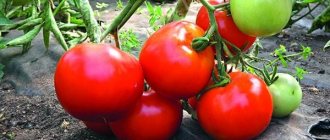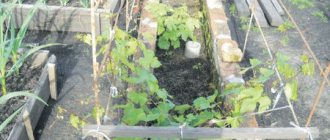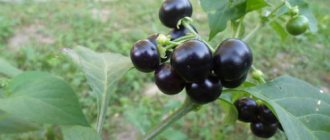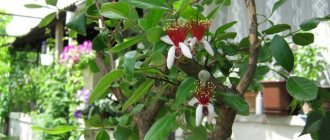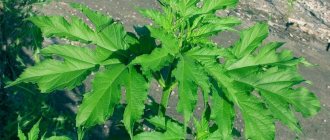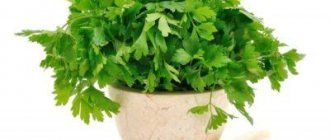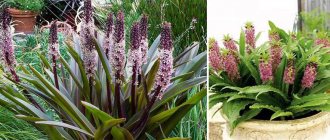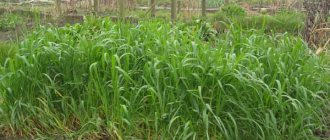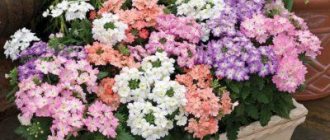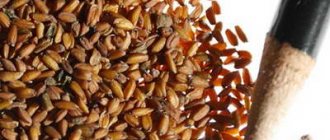Description
More often, alfalfa looks like a subshrub with a height of 0.6-1.5 m.
The root system with lateral branches has a powerful central rod that penetrates the soil to a depth of 10 m. Thanks to this, the grass is provided with nutrition that other plants do not receive. The root system of alfalfa, like all legumes, has small tubers containing nitrogen-fixing fungi. They participate in obtaining nitrogen from the air and enrich the earth with microelements.
Alfalfa stems are branched and extend straight from the base. The entire length of the shoots is covered with petiolate leaves, collected in groups of three. A rounded or elongated leaf is located on a small petiole. The outline of the leaf has teeth, and the underside is covered with lint.
Appearance
Flowers and fruits
The flowering phase begins 1.5-2 months after sowing and lasts 3-4 weeks. The flowering time of the inflorescence is about 10 days. Every day 3-5 fresh buds are formed. The color palette is often in blue, yellow, and purple tones. There are varieties of variegated colors.
Capitate or racemose heads appear from leaf axils or on the tips of young shoots. The inflorescences contain 10-25 buds and grow up to 8 cm. The corolla is formed by 5 petals and resembles a moth or swallowtail. From below, 2 of them are connected and form a bed for the stamen and pistil. The flowers are planted on short stalks. The lower buds open first.
Insects help pollinate flowers. After this, the ovary appears and fruits similar to beans, covered with a brown film, are formed. The shape of the beans is spiral or crescent-shaped. They store small yellow or brown bean seeds.
Description of the plant
Alfalfa plant, a perennial crop, from the legume family. In nature it is found growing wild. The roots of the plant are strong and thick, lying deep in the soil. The stem is straight, stable, covered with small, densely planted leaves, the plant height reaches 85 cm.
Inflorescences of blue and blue shades, collected in tassels, bloom in the summer. The fruits are hooked beans that reach maturity in August.
Asia is considered the birthplace of alfalfa; the wild plant is found in the Balkans, in Russia, and settles near water bodies, in forest edges and meadows. The main purpose of alfalfa is to feed livestock; the crop became known in the 6th century and was actively mowed for horse feed.
Alfalfa varieties
There are over 100 botanical species. About half of them grow in Russia.
- Hoppy alfalfa (pictured) is an annual or biennial plant. The taproot part is not very developed. The ground part is formed from thin stems growing 10-50 cm. The petiole leaves are rhombic in shape and small in size. They have a wedge-shaped base and glandular pile on the inside. Small yellow flowers form dense, egg-shaped inflorescences. The single-seeded fruit resembles a bean and is only 2 mm in size. The length of it is completely covered with pile.
Hop-like
- Crescent or yellow alfalfa forms a large subshrub 40-80 cm in height, fed by a highly developed rhizome. The stems are smooth or have little hair. Flowering begins in June-July, when the plant is covered with dense heads. Short pedicels hold from 7 to 40 buds. The length of mature sickle- or moon-shaped beans is 8-12 mm.
Crescent
- Seed or blue alfalfa with flexible stems of 80 cm. Leaves are obovate or small oval. Peduncles bear heads 2-3 cm long. The flowers are 5 mm in size in blue and purple tones. The bean fruits are curled up like snails.
Sowing
- Variable or hybrid alfalfa grows up to 70-120 cm. Branched shoots cover small leaves planted on elongated petioles. The shape of the leaves is oval or ovoid, and the underside is covered with sparse hair. The heads of inflorescences, 3-5 cm high, grow in the axils of the leaves and have long peduncles. The petals are colored yellow, blue, purple or variegated. Medium-sized spiral-shaped beans are covered with a pale yellow or brown shell.
Beneficial properties of alfalfa for soil
The benefit of alfalfa for people also lies in the fact that it can be used as green manure. This term refers to plants that are grown specifically to fertilize the soil. Green manure saturates it with minerals and nitrogen, and also prevents the growth of weeds. The functions of alfalfa will vary depending on the soil type. The plant loosens clay soil, and, on the contrary, strengthens sandy soil. Sometimes a medicinal plant is used to prepare liquid fertilizer. It fights soil acidification and saturates it with phosphorus.
Growing conditions
The area for planting alfalfa should be open and sufficiently lit. The shade slows down the development of the plant and the bushes will be low.
Nutrient-rich soil should be neutral or slightly alkaline. Loams are optimal for growing. In heavy, rocky, saline soils, alfalfa grows poorly due to weak nodule bacterial flora.
Keeping the soil moist without excess moisture, which causes powdery mildew to develop, is beneficial for development. Short-term drying of the surface layer of the earth is allowed. Regular watering is especially important for first-year plants.
The heat-loving crop feels good at t = +22-30°C and responds normally to an increase to t = +37-40°C. Plant care consists of weeding and hilling. Hilling helps prevent stems from lodging.
Agricultural technology
In many regions, alfalfa grows without any care, like a weed. Therefore, there will be no problems with its cultivation.
The area for planting is dug up with a spade in the fall. If the soil is very acidic and covered with moss, then after digging it is necessary to spread slaked lime. In the spring, the area needs to be fenced.
It is better to sow alfalfa in the spring early, immediately after the snow melts. During this period, the soil is filled with moisture. Small seeds can be mixed with sand for ease of sowing.
This plant does not require fertilization. It only needs sun and moisture.
The first time alfalfa is mowed is during flowering. This is approximately 2 months after sowing. If the land is not particularly neglected, in the fall the plants can be dug up, chopped with a shovel and embedded in the soil. In severely depleted areas, alfalfa is left to grow for another year or two to allow its roots to reach deep into the soil.
Sowing alfalfa
Alfalfa is bred by sowing seeds in open ground. Sowing work is carried out in the first month of spring.
Site preparation includes removing weeds, adding lime to the soil and digging. The application of mineral fertilizers promotes the growth of bushes and bright flowering. If necessary, moisten the soil. The seed material is treated with biological products to protect against various infections. Rows 5-12 cm deep are spaced at wide intervals of up to 45 cm. Sparse plantings provide maximum growth and pollination. To ensure even distribution, seeds are mixed with sand or fine sawdust.
Changeable
Sometimes mixed crops of alfalfa and cereals are used. However, if the alfalfa becomes thickened, it will receive little light, then its growth and seed ripening will be reduced.
At your dacha, you can simply scatter the seeds on loose soil and compact the surface with a sheet of plywood.
Growing alfalfa
Let's see step by step how the process of growing this crop occurs.
When to sow
To the question: “When to sow alfalfa seeds?” You can answer: spring, summer and autumn. Why is autumn better? Winter crop seeds are hardened in natural conditions, not at home. There is also a selection of more suitable seed material.
Summer sowing ensures rapid growth due to favorable conditions.
When planted in spring, the seeds sprout quickly due to the soil saturated with moisture. Typically, plant sowing dates occur in April.
Choose a place for sowing that is open and sufficiently lit. The chemical composition of the soil should be neutral or slightly alkaline.
Conditions
One of the conditions for proper cultivation of alfalfa is site preparation.
It consists of:
- weed removal,
- saturating the soil with lime and mineral fertilizers,
- digging up soil,
- moisturize if necessary.
Before planting, it is necessary to treat the seed material with biological products that protect against infections.
For planting over large areas, seeders equipped with depth limiters and disc coulters are used.
A distance of about 45 cm is left between the rows. When sowing alfalfa for the purpose of growing for animal feeding, the distance between the rows is reduced to 15 cm.
In the garden, the plant is not planted in rows. Simply scatter the seeds and compact the soil surface with plywood.
Seeding rate per hundred square meters
Calculated according to climatic conditions. In drier areas - up to approximately 120 g of alfalfa seeds, in places with wet weather - up to 160 g. Planting material for fields with artificial irrigation is taken from 140 to 160 g per hundred square meters.
Productivity per 1 ha for hay
Calculated when cutting alfalfa in the flowering or budding phase.
Caring for crops involves:
- moderate watering,
- getting rid of weeds,
- hilling to prevent bushes from lodging,
- fertilizing
Use in the agricultural sector
In garden plots and fields, alfalfa is used as green manure. Green fertilizer helps enrich the soil with nitrogen. The plant actively grows green mass and 8 mowings can be made per season. The decomposition of biomass in moist soil enriches the composition, promotes loosening, and reduces acidity. Alfalfa does an excellent job of restoring neglected areas.
Alfalfa has a rich composition of amino acids, phosphorus, potassium and protein, and is therefore considered a valuable feed for livestock. The peak nutritional value of alfalfa occurs during the budding period, and the most useful substances are in flowering alfalfa.
Green manure - green fertilizer
Procurement of feed raw materials is carried out 3 times per season. The first time the grass is mowed is during the budding period, and then during flowering. After the procedure, alfalfa will delight you with new flowers in 1-1.5 months. After mowing, a stem about 10 cm high should remain above the ground. This length is enough for quick restoration.
Green raw materials are used as top dressing or dried for hay, and then briquetted.
Chemical composition of alfalfa
Alfalfa contains many vitamins and minerals. The inflorescences and young shoots of the plant have the greatest number of beneficial properties. They are used not only for medicinal purposes, but also eaten. The composition of the plant is represented by the following components:
- alimentary fiber;
- amino acids;
- flavonoids;
- saponins;
- anthocyanins;
- vitamins of groups PP, B, A, C, K and E;
- macro- and microelements (iron, zinc, copper, phosphorus, calcium, magnesium, selenium, copper, sodium, potassium);
- chlorophyll;
- essential oils;
- phytoestrogens;
- fatty acid;
- ketones;
- alkaloids.
Due to its alkaloid content, the plant has a mild sedative effect. This allows it to be used for sleep disorders and nervous disorders. Anthocyanins have antibacterial properties, and saponins regulate nerve impulse transmission from the central nervous system to muscles.
Ketones transport oxygen and nutrients to cells. Due to dietary fiber, the plant has the ability to normalize the functioning of the gastrointestinal tract. Due to the content of phytoestrogens, it is used in the treatment of gynecological diseases. Chlorophyll in the plant strengthens blood vessels, thereby improving blood circulation.
how to sow alfalfa by hand: video
- Alfalfa as green manure
It saturates the soil with nitrogen and nutrients - a good fertilizer for humus plants. It has phytosanitary properties - it will get rid of litter and nematodes, and it is a godsend for earthworms and beneficial bacteria for the soil! It is very useful for many vegetables and fruit trees. The time for planting green manure is early spring. The soil needs to be loosened (25 centimeters). The depth of planting in bulk is 1 - 3 cm. Alfalfa consumption (norm) is 1.0 - 1.5 grams per square meter, about 100 - 150 g per hundred square meters.
For 15 acres it takes about 4 kilograms of honeydew; it can be sown together with sand, mixed in half.
- Alfalfa as a honey plant
For these purposes, blue or seed alfalfa is used . It is frost-resistant, blooms from June 15 for about 40 days. You need to sow the seeds very early, having thoroughly cultivated the soil beforehand. From one hectare (hectare) you can collect about 300 kg of honey. This is with good watering. And without watering - 30 kilograms. Honey from this plant crystallizes quickly and has an amber hue .
What is alfalfa
Alfalfa (Medicago sativa) is an important forage crop in countries around the world and is sometimes also called Alfalfa. Although originally cultivated only in South-Central Asia, alfalfa has now become an internationally recognized crop due to its impressive nutritional content and versatility. This plant is primarily used as a raw material for animal feed and livestock. Alfalfa hay is especially prized. It remains an important plant crop for people. First of all, thanks to the valuable properties of alfalfa sprouts.
Alfalfa - beneficial properties and contraindications
How to use for medicinal purposes?
For medicinal purposes, the herb alfalfa or hop grass is mainly used. Dried herbs, extract and juice are used for therapy. You can also use freshly cut raw materials.
Plant raw materials
The most useful preparations are those collected during the flowering period. The stems with leaves are cut above the root and dried in a ventilated room, secured under the roof in compact bunches. It is preferable to store raw materials in cloth bags in a dry place for no longer than a year.
Examples of using:
- To heal injuries, apply a paste of freshly picked leaves to the damaged area. It needs to be changed within 24 hours.
- For patients with heart and blood vessels, a drink is prepared from dry herbs. 6 tablespoons are poured into ½ liter of boiling water and left for 6-7 hours. You should drink a quarter glass three times a day before meals for at least a month.
- To reduce sugar levels, prepare a decoction in a water bath from 2 teaspoons of herbs and a glass of boiling water. The raw materials are simmered in a bathhouse for a quarter of an hour and infused for an hour without heating. It should be used fresh during the day, preferably divided into 6 doses. The duration should be agreed with the doctor, and the effectiveness should be monitored with a glucometer.
- Joint pain is relieved by drinking alcohol tincture. Five tablespoons of dry raw materials are poured into a bottle of vodka and infused in a glass container in the dark for 2 weeks. Take the product in the form of drops (10/half glass of water) three times a day before meals.
- To relieve the unpleasant symptoms of menopause, prepare a decoction of a tablespoon of dry alfalfa. The raw material is poured with half a glass of water, heated to a boil, and boiled for 5 minutes. And they insist for 3 hours. A serving is drunk before meals. This potion is prepared three times a day. (Does sage help with menopause?)
Freshly cut young shoots can be added, like greens, to salads and other dishes to tone up.
Extract
The pharmaceutical drug Eramin is an extract of alfalfa. Modern technologies have made it possible to preserve and enhance the natural qualities of the plant. The product has been tested and is registered with the Ministry of Health of the Russian Federation. The extract is available in the form of powder, resinous mass and capsules. It is added to ointments and creams.
The main areas of application of Eramin:
- pathologies of all parts of the gastrointestinal tract, including infections (used externally for hemorrhoids);
- respiratory problems (ingestion and inhalation);
- diseases of the nasopharynx and oral cavity (ingestion, lotions and rinses);
- prevention of oncology, relief of symptoms of chemotherapy;
- joint pain, fractures (accelerates bone healing);
- pathologies of the genitourinary system (tampons, douching, suppositories);
- diathesis, skin inflammation, allergies.
If agreed with a doctor, the medicine can be used for endocrine disorders, including to alleviate insulin dependence. Extracts are also known under other trade names from different manufacturers.
Juice
You can prepare the juice yourself by scrolling the leaves and stalks of alfalfa in a meat grinder and squeezing, or grind it with a blender and squeeze it with a press. In addition, you can purchase a product such as “Liquid Chlorophyll” from the American company NSP in the online store. It is essentially alfalfa juice mixed with mint oil, glycerin and water. “Liquid chlorophyll” and natural juice fully possess the set of properties of fresh alfalfa and extracts listed above. They are used to lower cholesterol and blood sugar, increase immunity and tone of the body, strengthen bones, cleanse the body during constipation, help the heart and blood vessels, treat the gastrointestinal tract and genitourinary tract.
Important! Due to its high bioactivity, natural alfalfa juice can bring not only benefits, but also harm. It is recommended to mix it with carrot juice, lettuce or water in equal parts before use.
A mixture with carrot juice allows you to increase hemoglobin in case of anemia. The juice should be drunk on an empty stomach in the morning, 100-200 ml for 1-2 months, then take long breaks. There are different ratio recommendations, such as 12 parts carrot juice to 4 parts alfalfa juice, or a carrot/lettuce/alfalfa ratio of 9:4:3. In any case, you should not drink these mixtures for longer than 3 months.
Alfalfa classification
There are about 20 species of this plant. Let's take a closer look at them, exploring their applications and comparing the plants' appearance.
Alfalfa sickle / yellow
It grows in loose soil and can withstand cold and even frost. Used in agriculture and medicine . In the latter, as a drug for migraines, pneumonia, and kidney diseases. Can be taken with an accelerated heartbeat.
Alfalfa hop-like
An annual plant used as food for herbivores .
Sowing
Their names make it clear that such a plant is used for sowing .
Changeable
Winter-hardy plant, improves soil fertility and its structure .
Tree honeycomb
Forage plant, technical . The only type of alfalfa that is grown as an ornamental . in Greece, the leaves are eaten.
Begonia alfalfa
Eating and external use
Alfalfa is included in the diet in the form of decoctions, teas, tinctures, herbal cocktails, and young sprouts. Concentrated forms of alfalfa-based products are also used - tablets, powder (for example, Green Protection Vitamax), capsules (for example, Alfalfa NSP).
Powder from the leaves is used externally, which has a hemostatic and wound-healing effect. Compresses, masks, decoctions, creams and other cosmetics are also used.
Before using any alfalfa-based products, carefully read the relevant instructions (annotation).
Alfalfa care
Alfalfa loves open, well-lit places. In the shade it develops more slowly and forms lower growth. The soil for planting is preferably fertile and well-drained, with a neutral or slightly alkaline reaction. Loams are the most suitable. Alfalfa grows very poorly on saline, rocky or clayey soils with close groundwater. Such conditions are unfavorable for the development of nodule bacteria.
Although alfalfa can tolerate short-term drought, it thrives when the soil is regularly irrigated. The top layer of soil is allowed to dry out. With excessive humidity, powdery mildew develops quickly. The greatest sensitivity to watering occurs in the first year of the plant’s life.
Alfalfa is a heat-loving crop. It grows best at temperatures of +22...+30°C, but can easily tolerate heat up to +37...+42°C. Some varieties winter successfully in frosts down to -25...-30°C.
Young plants need protection from weeds, so they are regularly weeded and hilled.
To collect feed raw materials, alfalfa is regularly mowed. This is done for the first time at the budding stage, and again during flowering. She tolerates the procedures quite easily and is ready to delight with flowers again after 1-1.5 months. To prevent growth and lodging, horizontal cutting of roots is practiced using special cultivators and flat cutters.
In rare cases, alfalfa is affected by fungal diseases. Bordeaux mixture is used to combat them. The most annoying parasites include the alfalfa weevil, the alfalfa bug and the chickweed. They get rid of them using insecticides (“Benzophosphate”, “Fastak”).
